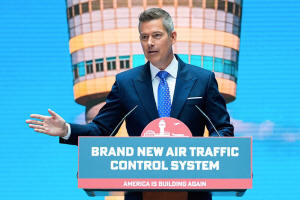White House overhaul of troubled US air traffic control system will cost
'lots of billions'
[May 09, 2025]
By JOSH FUNK and JOHN SEEWER
The Trump administration on Thursday proposed a multibillion-dollar
overhaul of a U.S. air traffic control system that it said still relies
on floppy disks and replacement parts found on eBay and has come under
renewed scrutiny in the wake of recent deadly plane crashes and
technical failures.
The plan calls for six new air traffic control centers, along with an
array of technology and communications upgrades at all of the nation’s
air traffic facilities over the next three or four years, said
Transportation Secretary Sean Duffy.
“We use radar from the 1970s,” said Duffy, who compared the proposal
with upgrading from a flip phone to a smartphone. “This technology is 50
years old that our controllers use to scan the skies and keep airplanes
separated from one another.”
How much it will all cost wasn’t immediately revealed. Duffy said he'll
work with Congress on the details.
“It’s going to be billions, lots of billions,” he said.
The plan has an aggressive timeline, calling on everything to be
finished by 2028 — although Duffy said it may take another year.
Demands to fix the aging system that handles more than 45,000 daily
flights have increased since the midair collision in January between an
Army helicopter and a commercial airliner that killed 67 people over
Washington, D.C.

That crash — and a string of other crashes and mishaps — showed the
immediate need for these upgrades, Duffy said in front of airline
officials, union leaders and family members of those who died in the
crash near Reagan National Airport.
The proposal sets out to add fiber, wireless or satellite technology at
more than 4,600 locations, replace 618 radars and more than quadruple
the number of airports with systems designed to reduce near misses on
runways.
Six new air traffic control centers also would be built under the plan,
and new hardware and software would be standardized across all air
traffic facilities.
The House Transportation and Infrastructure Committee last week budgeted
$12.5 billion to overhaul the system, but that estimate came out before
the Transportation Department revealed its plan. Duffy said the final
price tag will be higher.
U.S. Rep. Sam Graves of Missouri, who heads the House transportation
committee, called the amount only a “down payment.”
To build the system quickly, as planned, Duffy said Congress must give
the Federal Aviation Administration all the money up front and
streamline the permitting process.
“The system we have here? It’s not worth saving. I don’t need to
preserve any of this. It’s too old,” Duffy said.

[to top of second column]
|

Transportation Secretary Sean Duffy announces a new air traffic
control infrastructure plan, Thursday, May 8, 2025, in Washington.
(AP Photo/Julia Demaree Nikhinson)

Trump said Thursday that the plan will revolutionize flying. “The
new equipment is unbelievable what it does,” he said from the Oval
Office. He began to say it may even alleviate the need for pilots
before adding, “In my opinion, you always need pilots. But you
wouldn’t even have to have pilots.”
The newly revealed proposal appears to have wide support across the
aviation industry — from airline CEOs to the unions representing
controllers and pilots — but this is just the beginning and many
details haven’t been revealed.
Duffy quickly said the plan will not involve privatizing the air
traffic control system, as Trump had supported in his first term.
Following the midair crash near Washington, Trump promised to fix
what he called “an old, broken system” and to tackle the nationwide
shortage of air traffic controllers while blaming the previous Biden
administration for both problems.
But the weaknesses within the air traffic control system have been
highlighted for years in hearings before Congress and government
reports. The struggles to keep up with increasing air traffic has
been recognized since the 1990s — long before either Trump or Biden
took office.
The Trump administration’s overhaul plan will need enough funding to
be more effective than previous reform efforts during the last three
decades. Already more than $14 billion has been invested in upgrades
since 2003 but none have dramatically changed how the system works.
The FAA has been working since the mid-2000s to make upgrades
through its NextGen program.

One of the biggest challenges with a massive upgrade is that the FAA
must keep the current system operating while developing a new system
and then find a way to seamlessly switch over. That’s partly why the
agency has pursued more gradual improvements in the past.
The shortage of controllers and technical breakdowns came to the
forefront in the last two weeks when a radar system briefly failed
at the Newark, New Jersey, airport, leading to a wave of flight
cancellations and delays.
Without the planned upgrades, those breakdowns will be repeated
around the nation, Duffy said. “Newark has been a prime example of
what happens when this old equipment goes down,” he said.
___
Associated Press reporter Will Weissert in Washington contributed.
All contents © copyright 2025 Associated Press. All rights reserved |